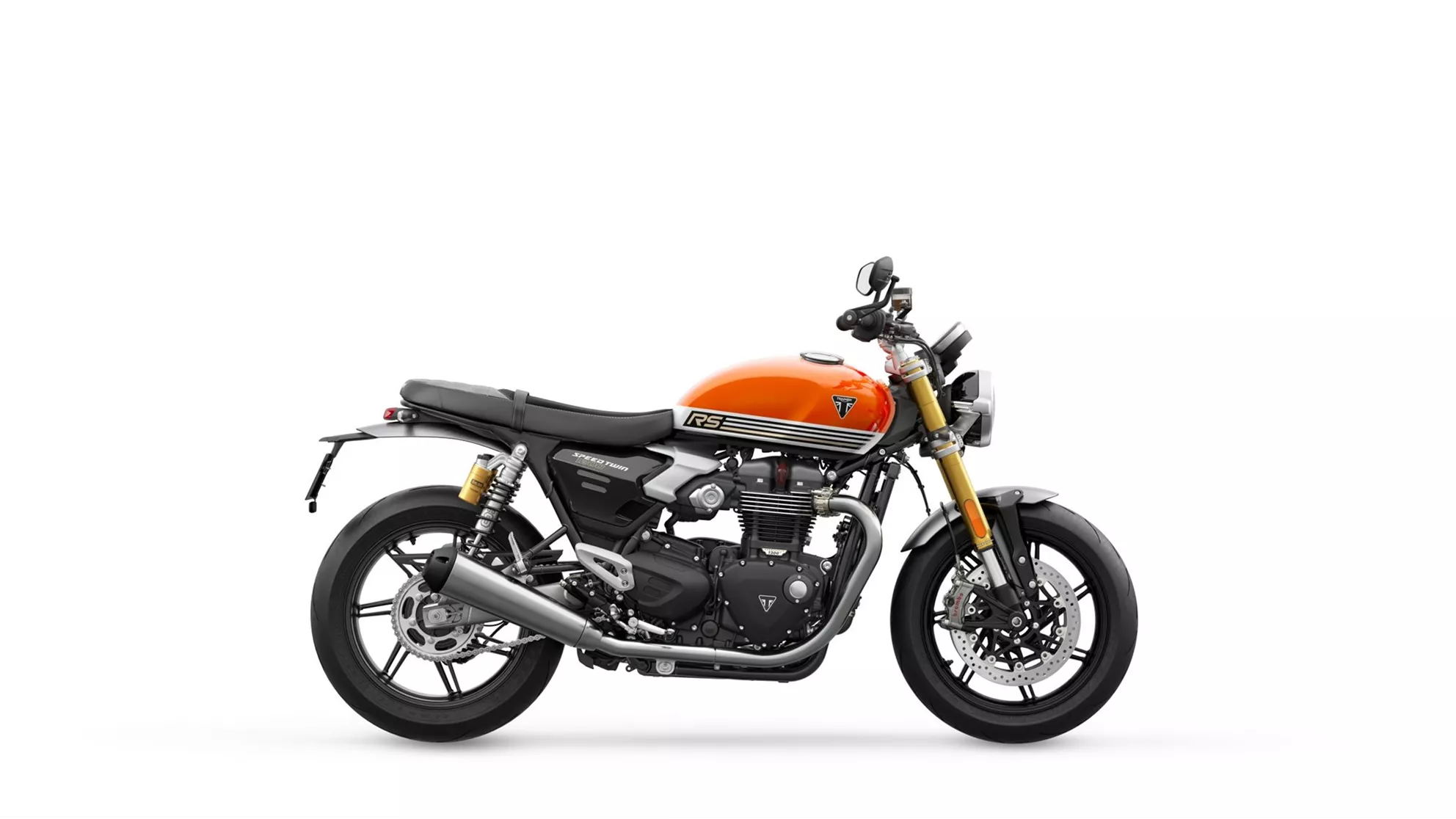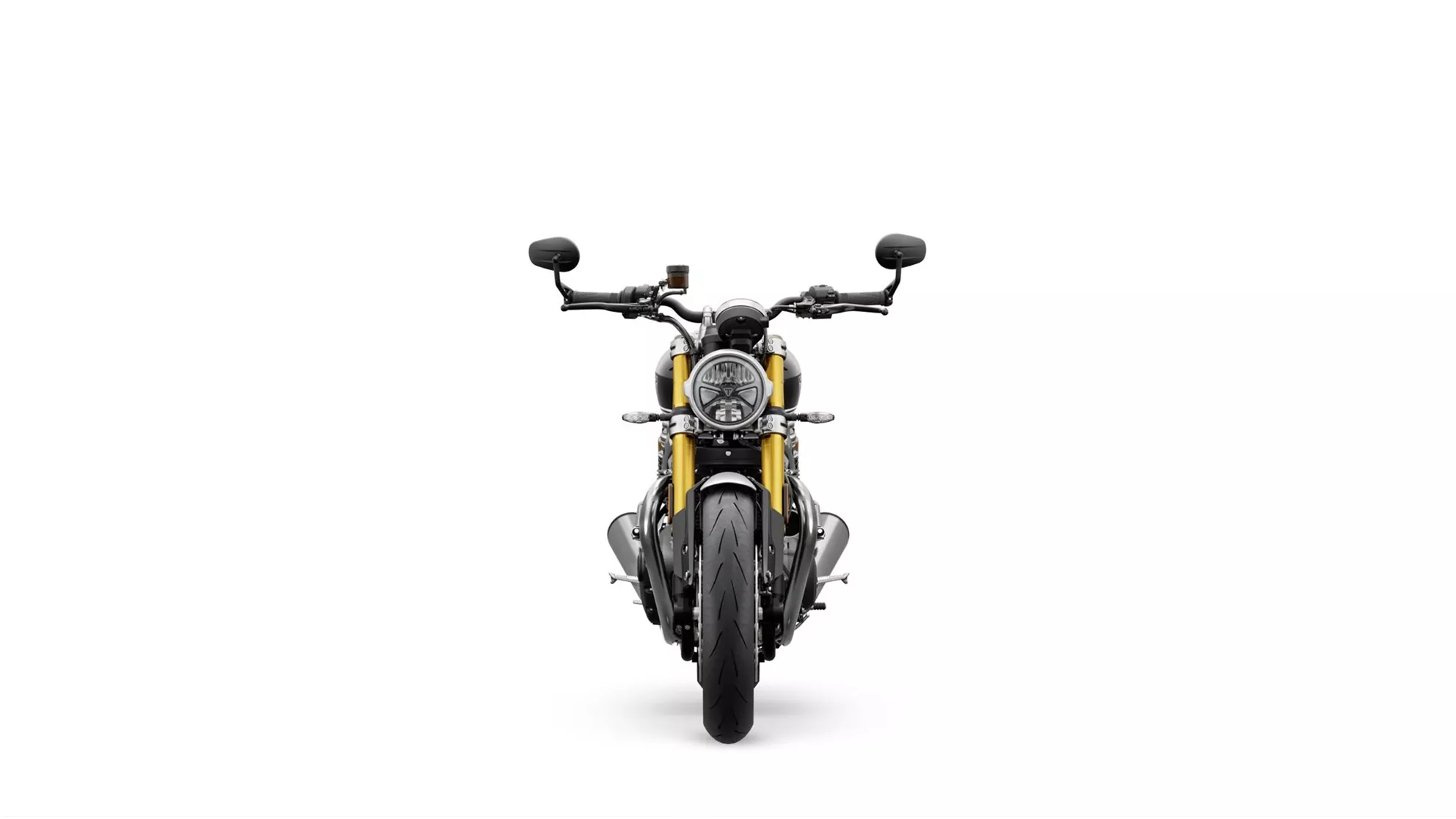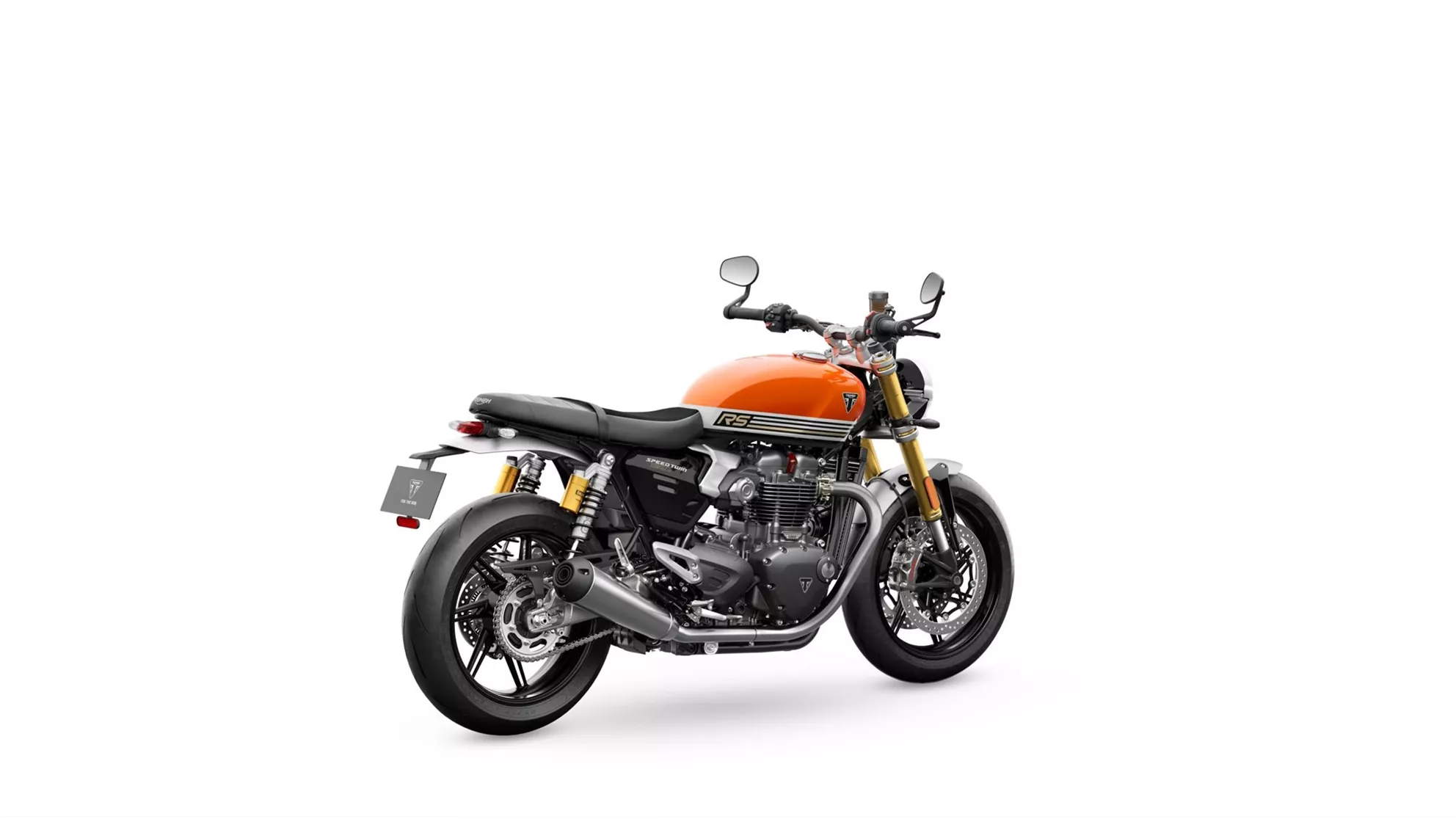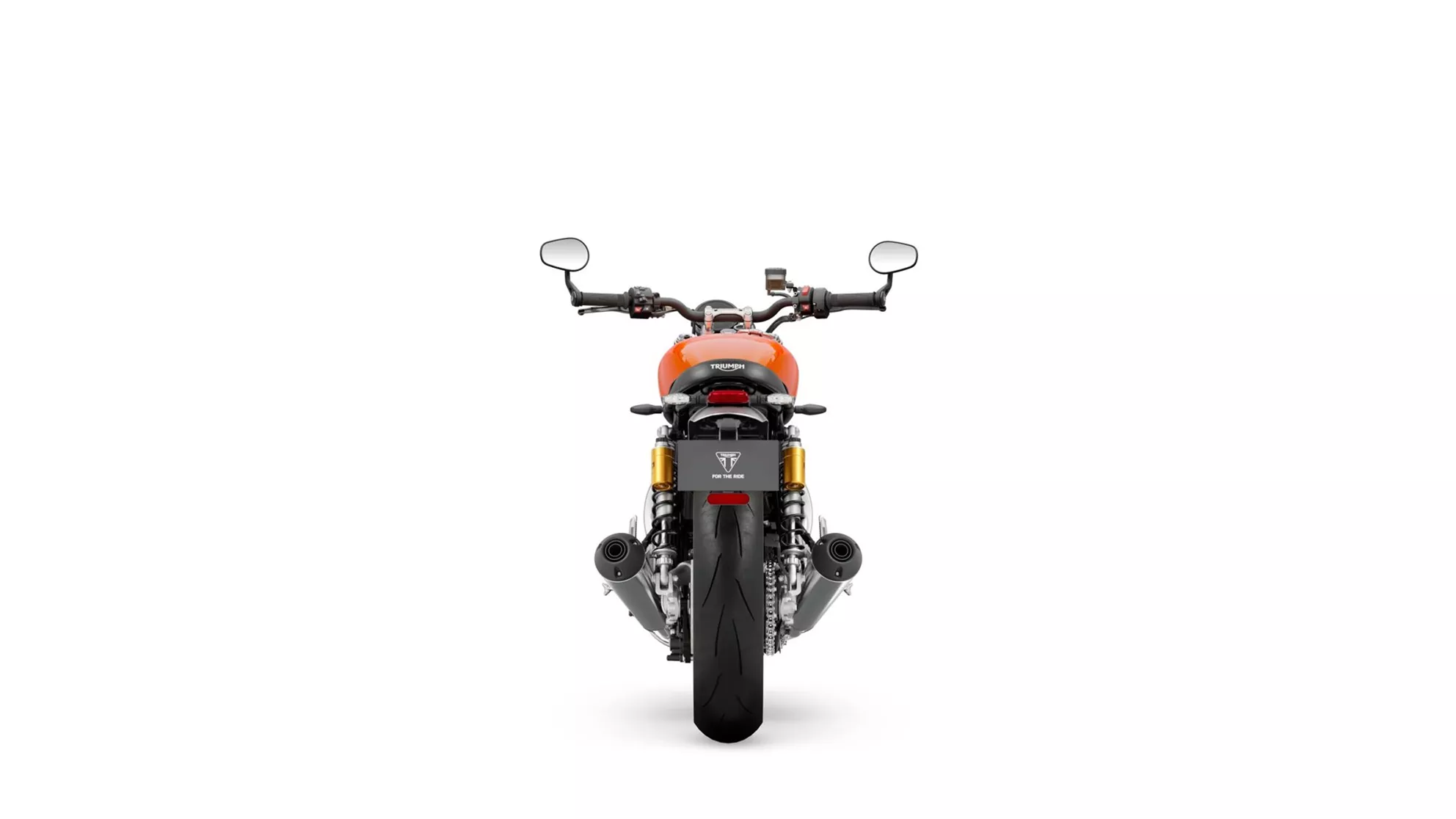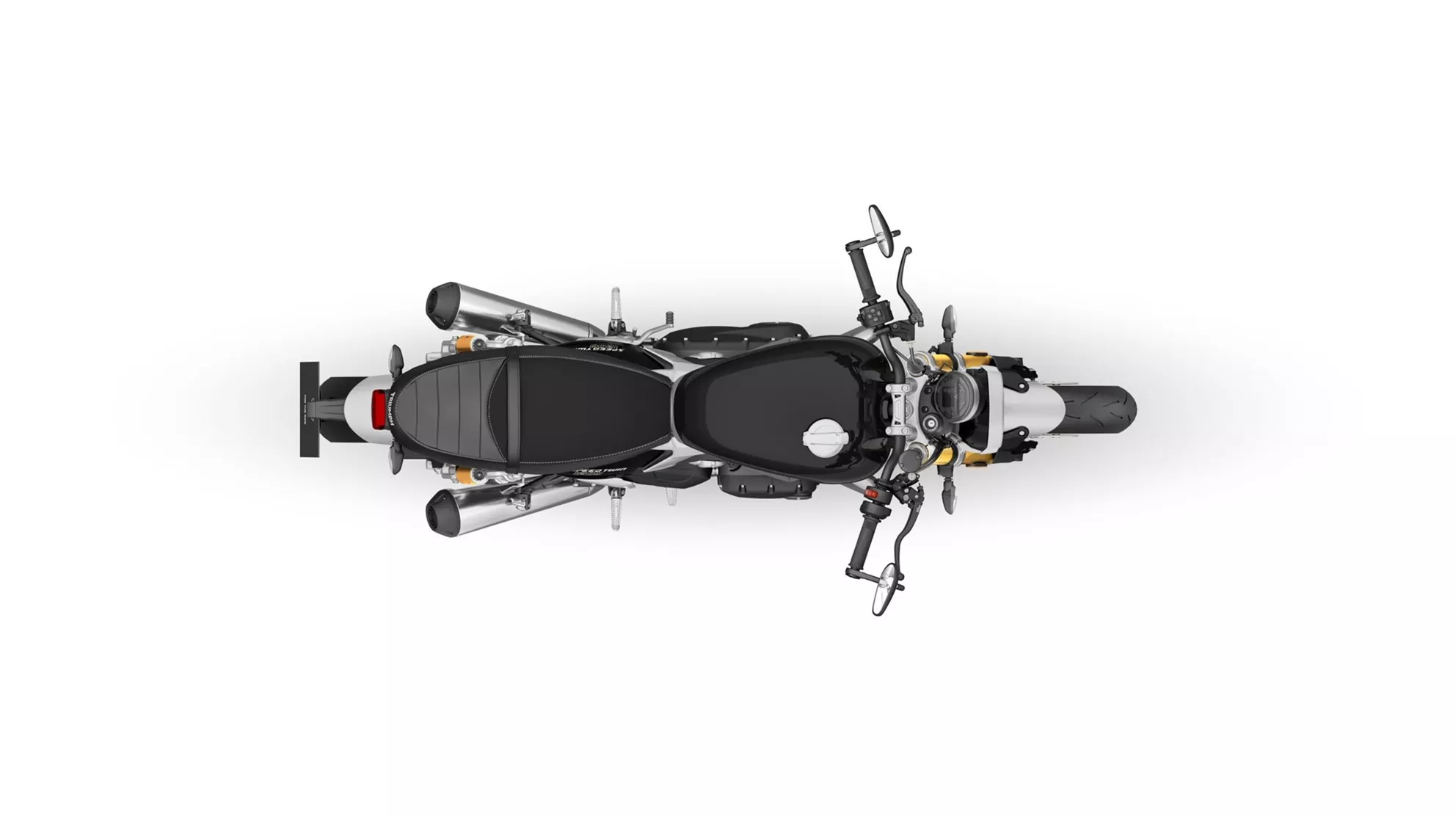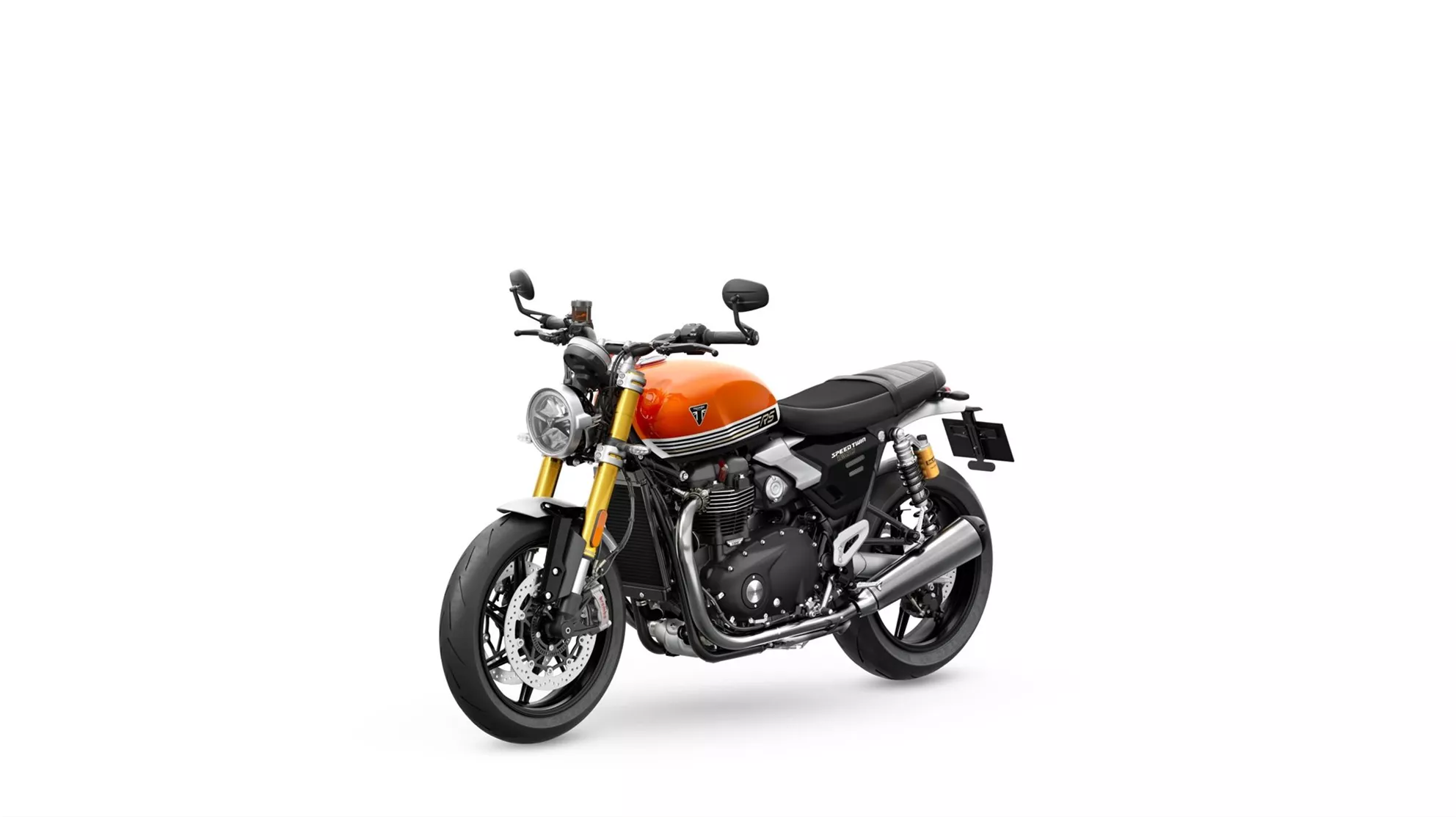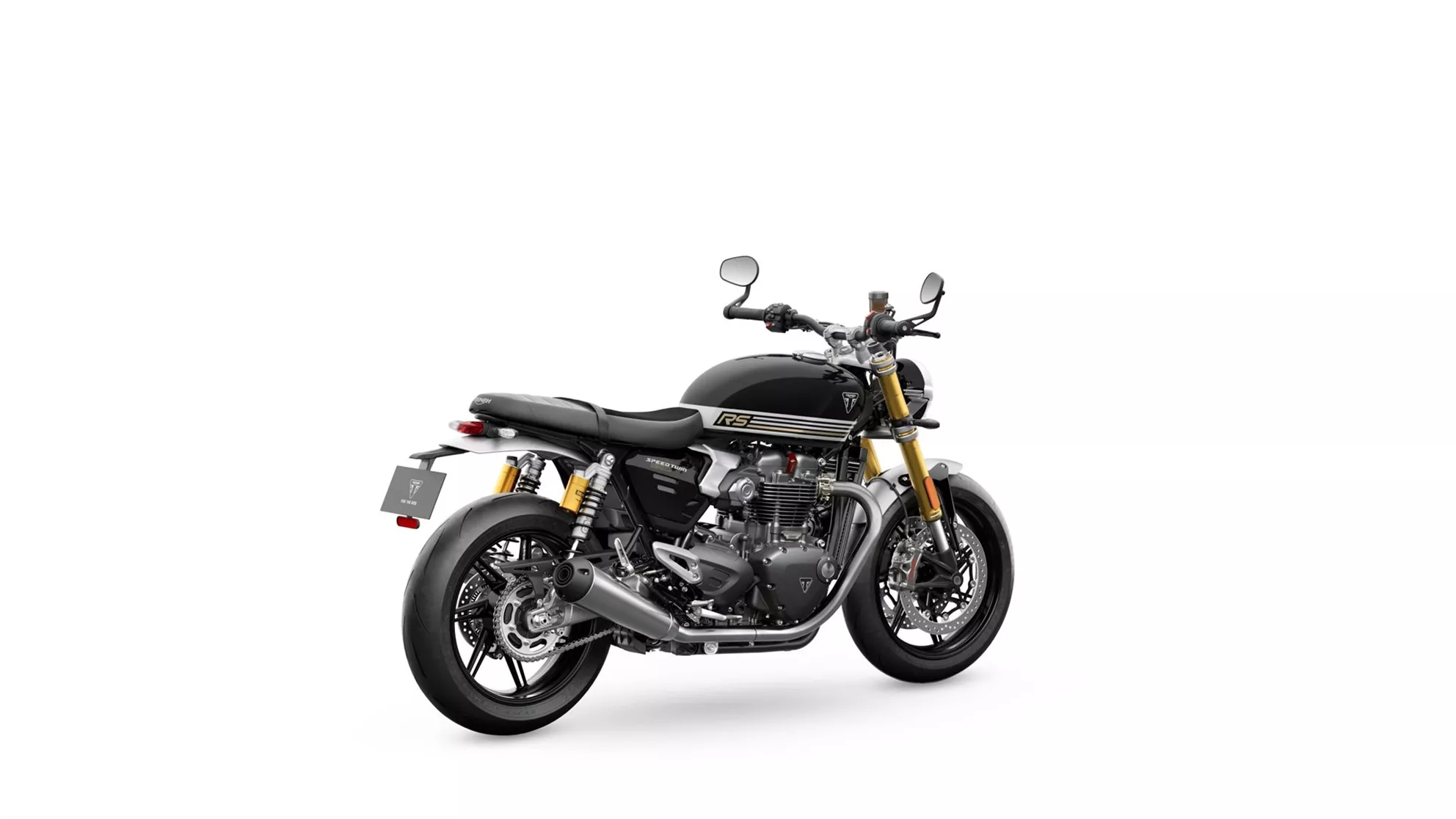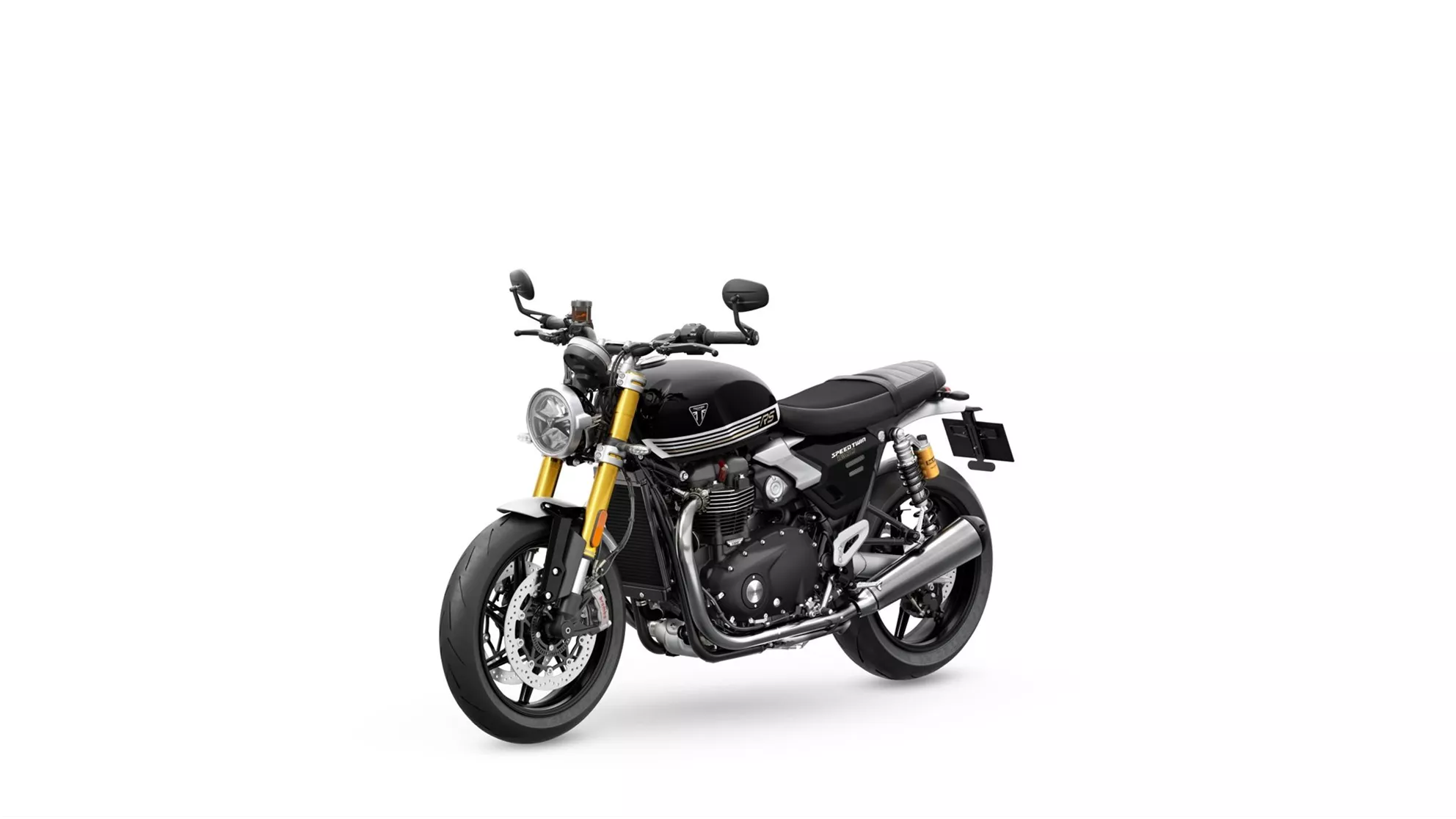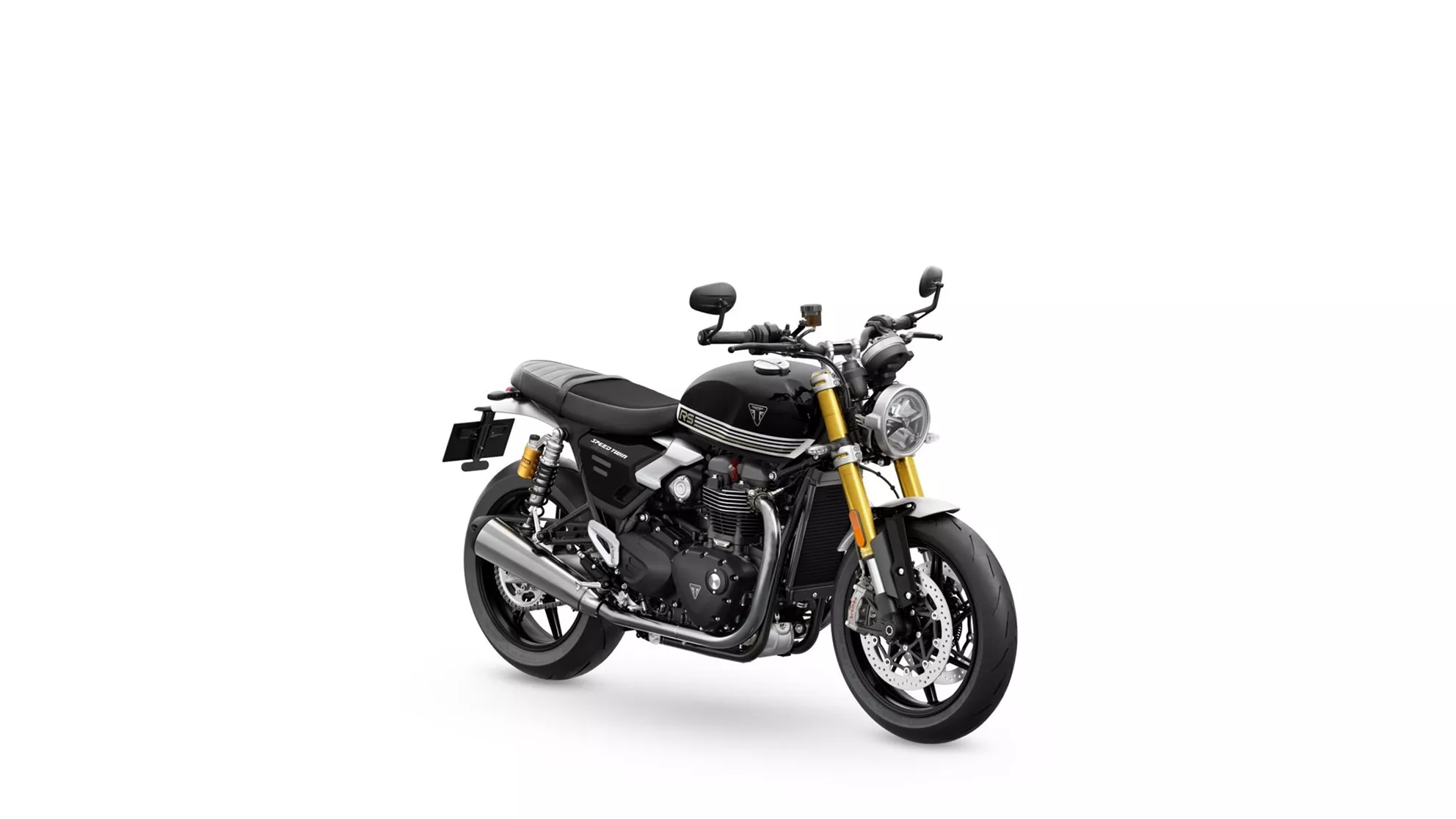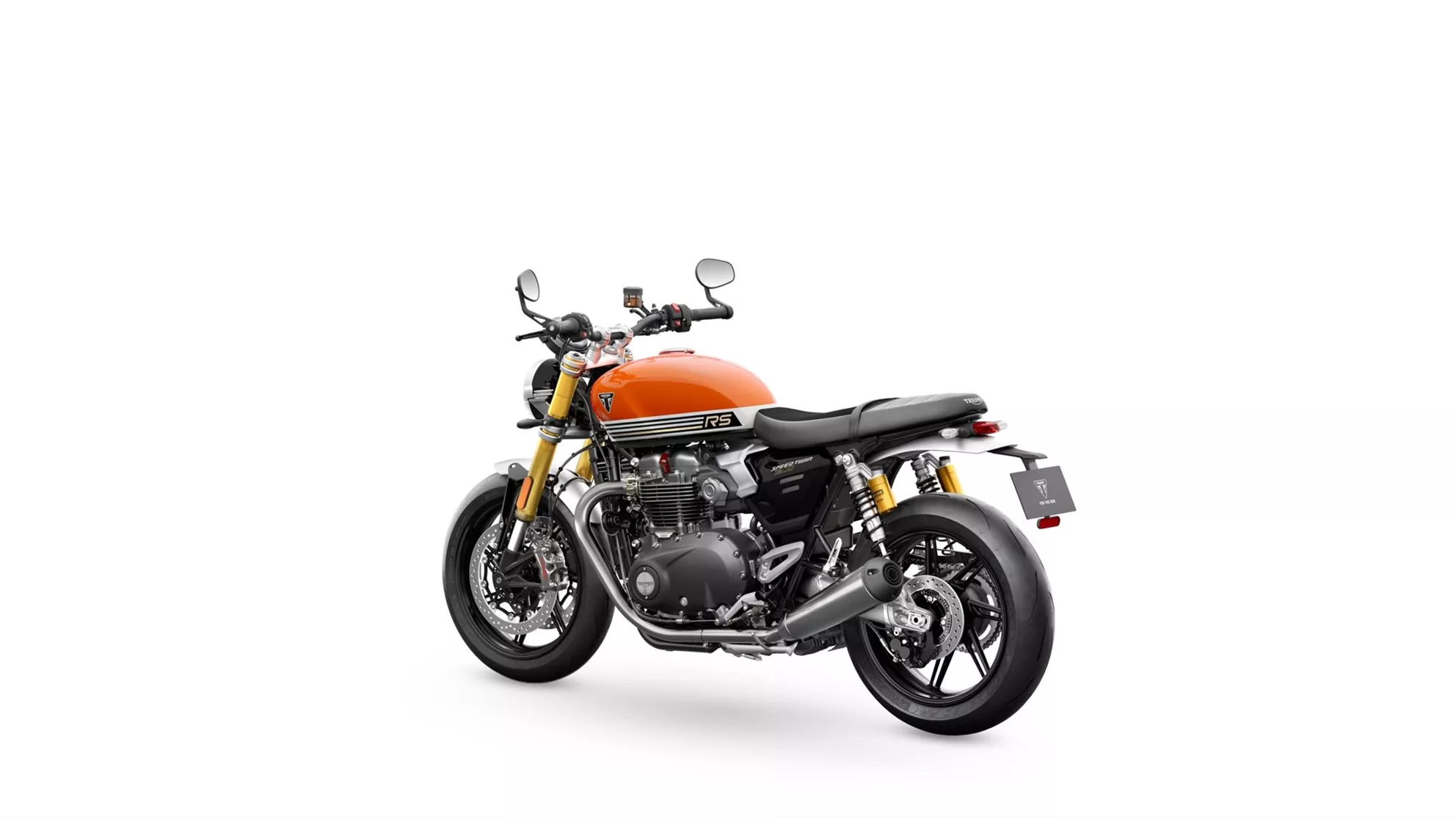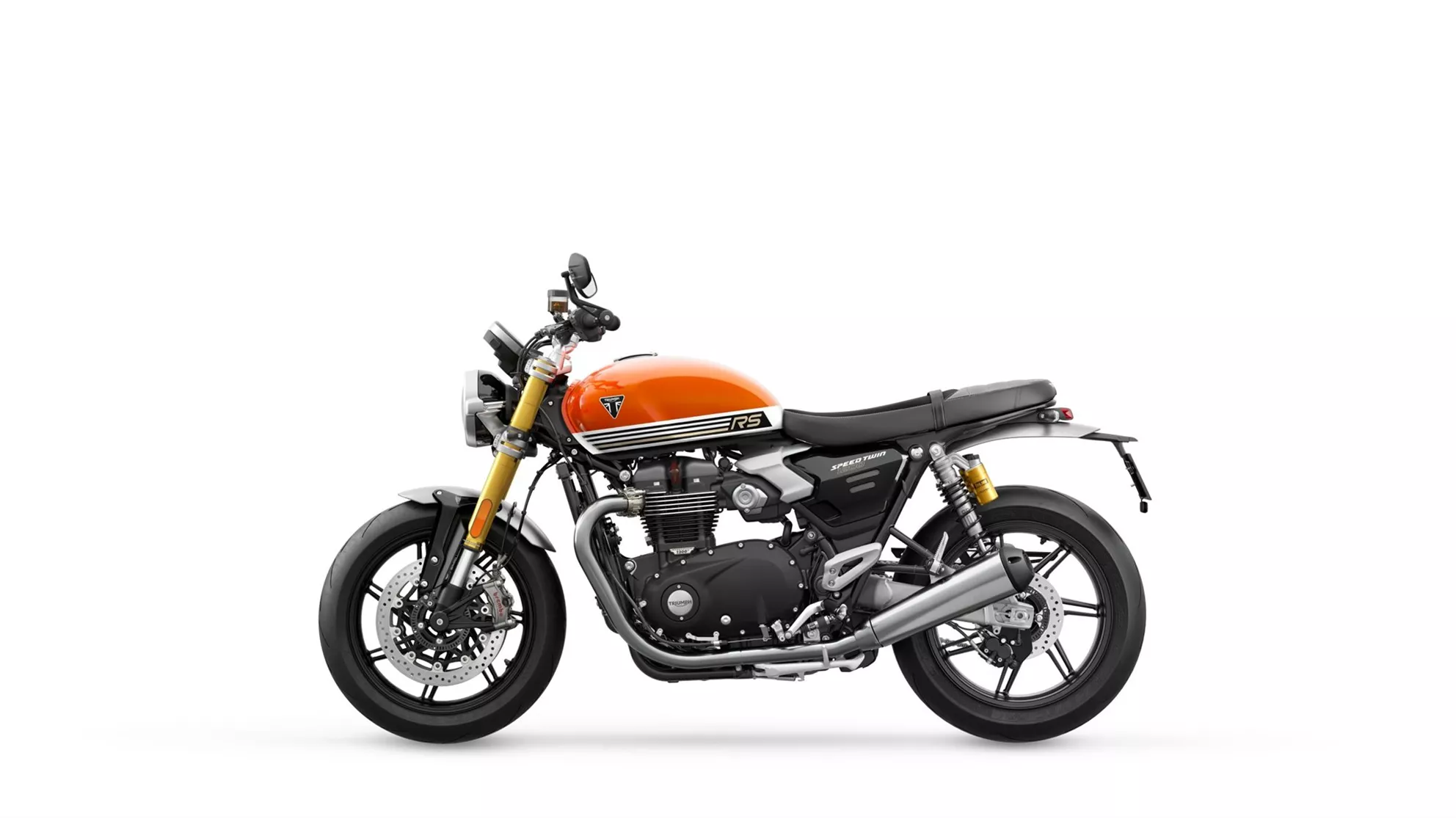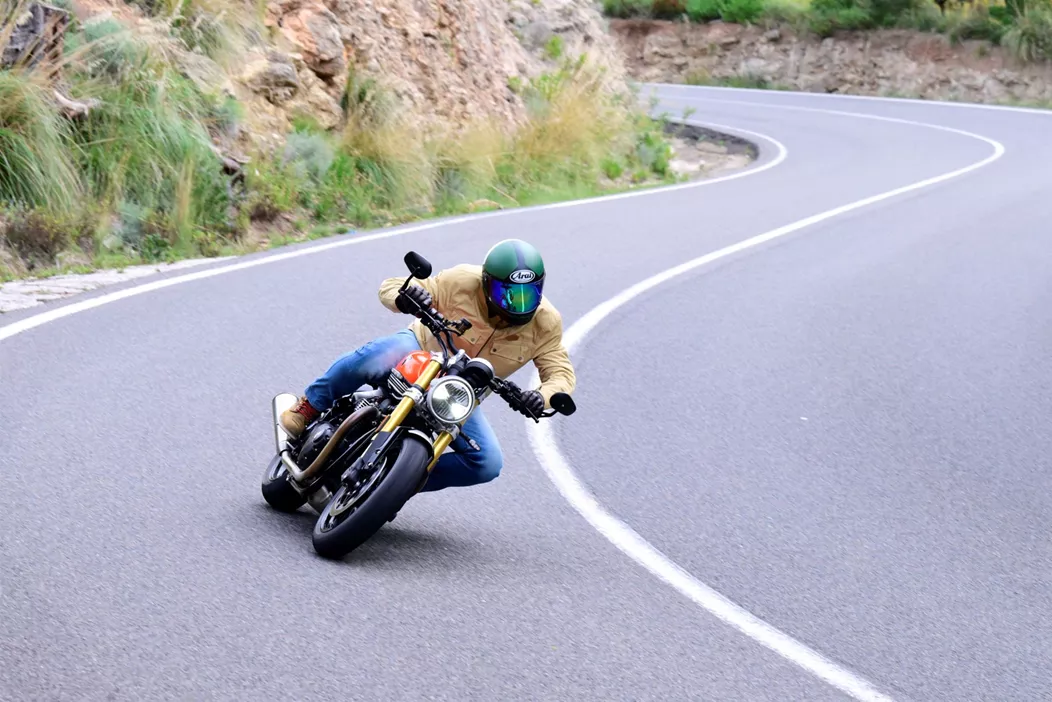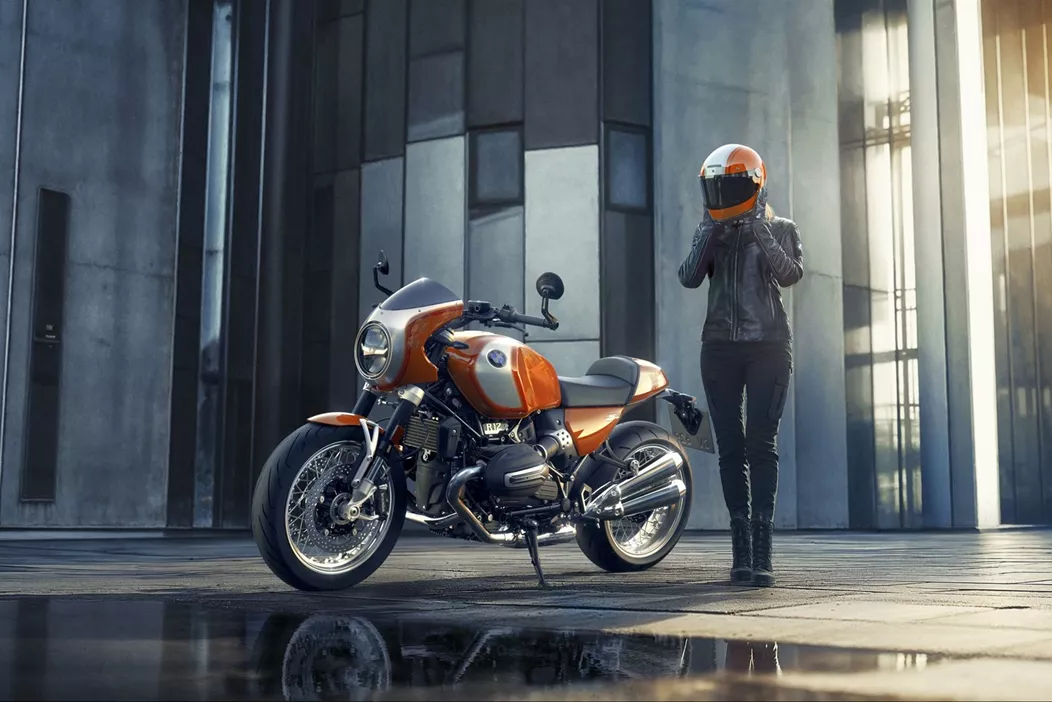While the Triumph Speed Twin 1200 RS is priced at €16,195 in Germany (€18,695 in Austria), you'll need at least €22,495 for the BMW R12 S in Germany (€25,890 in Austria). If you explore options with the BMW configurator, even the base model of the R 12 Nine T quickly reaches prices around €20,000. Triumph offers an interesting in-house alternative with the more affordable Speed Twin 1200, which shares many of the RS model's advantages but comes with less equipment.

Triumph Speed Twin 1200 RS vs. BMW R12 S Head-to-Head Comparison Test
Which Modern Retro Bike Stands Out?
The Triumph Speed Twin 1200 RS and the BMW R12 S are two motorcycles that blend classic aesthetics with cutting-edge technology. An in-depth comparison test of these dream retro machines in Spain.
&width=72&height=72&bgcolor=rgba_39_42_44_0&mode=crop)
Poky
published on 3/14/2025
The Bitter Pill First: Pricing for Triumph Speed Twin 1200 RS and BMW R12 S 2025
Design and Presentation: Triumph Speed Twin 1200 RS vs. BMW R12 S – Timeless Retro Aesthetics?
These two motorcycles are not just about getting from A to B; they're true design statements. They blend classic styling with premium materials and modern elements. While the BMW R 12 S in the Daytona Edition sticks exclusively to the classic two-tone "Lava Orange Metallic" paint job, the Triumph is available in the understated "Sapphire Black" and the striking "Baja Orange." Our test bike sports the latter, making both bikes gleam in the sunset along the Spanish coast.
Visually, both bikes boast meticulously designed tanks (though, unfortunately, the gorgeous lines are just overlaid stickers!), highlighted paint jobs, and high-quality materials. Yet, there's a clear distinction: Triumph leans more towards metal, while BMW employs plastic in certain areas, like the heat shield, side covers, and front fender. Both bikes feature bar-end mirrors—an element more typical of modern motorcycle design. While not entirely period-correct, they suit these classics beautifully. Both motorcycles utilize modular design principles, sharing handlebar controls with more affordable mid-range bikes like the F 900 R and Trident 660, which might leave some expecting more.
Engine Comparison: BMW R12 S vs. Triumph Speed Twin 1200 RS – Boxer vs. Parallel Twin
The key differentiator between these two motorcycles lies in their engine characteristics. The Triumph Speed Twin 1200 RS features a 1200cc parallel-twin with a crank pin offset, delivering 105 horsepower and 112 Nm of torque. This engine impresses with its punchy low-end power and a very smooth throttle response. Thanks to a slightly higher redline, the current model packs five more horsepower than its predecessor, offering solid pull-off power and a broad, usable torque range right from the start. In "Sport" mode, the engine is particularly responsive, enhancing dynamic riding with its silky-smooth throttle response.
In contrast, the BMW R12 S uses its 1170cc boxer engine, producing 109 horsepower and 115 Nm of torque. The boxer delivers power more evenly, revs higher, and offers more reserves in the upper rev range compared to the Triumph. However, the throttle response in "Dynamic" mode is quite direct and can feel abrupt if not handled gently—"Road" mode is a better choice here. In urban environments, the BMW excels with its ability to deliver significant thrust even at low revs, allowing for lazy shifting.
Both models come standard with quickshifters for clutchless up and downshifting. The quickshifters perform satisfactorily but not at the refined level one might expect from the brands' multi-cylinder models—Triumph's triple and BMW's four-cylinder machines. Notably, the boxer transmits its characteristic sideways jolt to the vehicle when downshifting, which can unsettle the chassis.
Chassis and Handling: Triumph Speed Twin 1200 RS vs. BMW R12 S – Agility or Stability?
The suspension systems of both motorcycles are high-quality, but they are tuned with different priorities. The Triumph Speed Twin 1200 RS features a fully adjustable 43mm Marzocchi upside-down fork and Öhlins twin shocks. The combination of 120mm front and 123mm rear travel ensures a sporty, direct suspension setup with plenty of front-end feedback. In corners, the Triumph delivers highly precise feedback, encouraging a more active riding style.
The BMW R12 S also employs a fully adjustable upside-down fork with 120mm travel and an Öhlins central shock absorber, with preload adjustable via a handy handwheel. The BMW offers a more comfortable ride overall, as its suspension absorbs bumps better, but it requires more deliberate inputs on the nicely wide handlebars to lean into corners. The knee grip around the broad tank is effortless and notably easier than the narrow waist of the Triumph.
The "S" in the BMW's name sets an expectation of sportiness that the R12 S can only partially fulfill due to its limited lean angle. Conversely, the Triumph allows for lean angles that are better suited for the racetrack.
Despite similar power figures, there is a clear difference in handling dynamics. The Triumph is more agile, which is especially noticeable during quick directional changes. The BMW, on the other hand, remains more stable in corners and exhibits less tendency to stand up under braking, allowing for a smoother ride. Those seeking a more active, precise machine will gravitate towards the Triumph, while those who prefer comfort will find the BMW a better fit.
- How much does a Triumph Speed Twin 1200 RS cost?
- Here you will find an overview of the price level of new and used motorbikes!
Brakes: Triumph Speed Twin 1200 RS vs. BMW R12 S
The braking systems on both motorcycles are top-notch but differ in their characteristics. The Triumph Speed Twin 1200 RS is equipped with Brembo Stylema dual disc brakes, which are very sharp and have a direct response, tailored for sporty riding. The BMW R12 S also features a high-quality but slightly older Brembo M4.32 setup, which is less aggressive in its initial bite. However, it shines with better modulation and offers more stability when braking in a lean.
Ergonomics: Triumph Speed Twin 1200 RS vs. BMW R12 S – Sporty Aggression or Relaxed Confidence?
The Triumph Speed Twin 1200 RS and the BMW R12 S both offer sporty seating positions but differ significantly in terms of ergonomics and riding comfort. On the Triumph, the rider sits in a more compact, forward-leaning stance. The 810mm seat height, coupled with the narrow tank, provides plenty of freedom in the saddle, which is beneficial for both spirited cornering and comfort on longer rides. The Speed Twin's narrow waist and accessible seat height make it a good fit even for riders under 1.75 meters. The footpegs are relatively high and set back, underscoring the bike's sporty intent. For those who prefer a more active riding position and enjoy tackling tight corners with vigor, the Triumph feels refreshingly direct. However, the tight legroom might cause more strain on the knees during extended rides.
In comparison, the BMW R12 S offers a more relaxed ergonomic setup. Its seat height is slightly lower at 795mm, making it more accessible for shorter riders. The wide handlebars promote an upright seating posture and provide better leverage for slow maneuvers or city riding. The knee angle is less acute than on the Triumph, making the BMW more comfortable over long distances. At the same time, the seating position remains sporty enough to deliver precise feedback in curves. A minor downside is the design of the footpegs: they scrape relatively early, limiting lean angles in spirited cornering.
In summary, the Triumph Speed Twin 1200 RS offers sportier, more active ergonomics, while the BMW R12 S provides better long-distance comfort and a more relaxed posture. Riders seeking a particularly agile feel and who don't mind a slightly cramped seating position will be happier with the Triumph. However, those who frequently embark on longer journeys or want a more comfortable riding experience combined with the ability for sporty outings will find the BMW a better fit. If you're ready to spend a bit more, you can further customize your R 12 S in the BMW Configurator.
Comparison Verdict: Triumph Speed Twin 1200 RS vs. BMW R12 S
Both machines are technically refined and crafted to a high standard. The choice between Triumph and BMW largely depends on riding style. The Triumph Speed Twin 1200 RS appeals to sport-oriented riders who value direct feedback and agile handling. Its parallel twin delivers ample low-end torque but demands a more active riding style. The firm suspension and sharp brakes emphasize its dynamic nature. Additionally, it impresses with a strong price-performance ratio. On the other hand, the BMW R12 S caters to riders who appreciate comfort and classic boxer charm. Its composed engine allows for a more relaxed, gear-shy ride, the suspension is more comfortable over long distances, and the brakes offer softer modulation. However, BMW comes with a noticeable price premium, which may not be seen as justified by everyone. The Triumph Speed Twin 1200 RS is the better choice for sporty riders on a budget. In contrast, the BMW R12 S offers the boxer experience, confidence, and exclusive design at a significantly higher price.
Note: The following individual conclusions are taken from the respective vehicle tests.
- How much does a BMW R 12 S cost?
- Here you will find an overview of the price level of new and used motorbikes!
&width=60&height=60&bgcolor=rgba_39_42_44_0&mode=crop)
Triumph Speed Twin 1200 RS 2025 - Experiences and Expert Review
Poky
With the new Speed Twin 1200 models, Triumph offers two exceptional machines that beautifully combine retro styling with modern technology. The powerful 1200cc parallel twin engine is now paired with state-of-the-art electronics, delivering a glorious sound. The elegantly equipped RS feels right at home on twisty roads. Its sporty ergonomics with an active riding position, precisely tuned firm suspension, and sharp Brembo brakes make it the perfect choice for ambitious riders. Despite its sporty setup, the ride comfort remains surprisingly good.
&width=60&height=60&bgcolor=rgba_39_42_44_0&mode=crop)
BMW R 12 S 2025 - Experiences and Expert Review
Poky
With the R 12 S, BMW has crafted a desirable top model in the R 12 series. A feel-good engine paired with high-quality components and stunning looks brings a smile to the rider's face. The special paint job takes you back to the era of BMW's first faired motorcycle, the legendary R 90 S. In terms of ride dynamics, the BMW is thoroughly modern thanks to various features. Those who interpret the S as a sign of exceptional sportiness might be disappointed due to limited lean angles. However, everyone else will be truly delighted with the visual feast that is the R 12 S, provided their wallet is sufficiently stocked.
More from 1000PS Magazine
Triumph Speed Twin 1200 RS vs. BMW R12 S Head-to-Head Comparison Test Images
Source: 1000PS

Triumph Speed Twin 1200 RS vs. BMW R 12 S
Triumph Speed Twin 1200 RS vs. BMW R12 S - Which Modern Retro Bike Stands Out?

BMW R 12 S
The Triumph Speed Twin 1200 RS and BMW R12 S are two motorcycles that blend classic styling with modern technology.

Triumph Speed Twin 1200 RS
Intensive comparison test of dream retro bikes in Spain.

Triumph Speed Twin 1200 RS
While the Triumph Speed Twin 1200 RS is available for €16,195 in Germany (€18,695 in Austria),

BMW R 12 S
you'll need at least €22,495 in Germany (€25,890 in Austria) for the BMW R12 S.

Triumph Speed Twin 1200 RS vs. BMW R 12 S
These two motorcycles are not just means of transportation but true design statements. They combine classic styling with high-quality materials and modern elements.

BMW R 12 S
While the BMW R12 S in the Daytona Edition exclusively features the classic two-tone "Lava Orange Metallic" paint scheme,

Triumph Speed Twin 1200 RS
the Triumph is available not only in the subtle "Sapphire Black" but also in the striking "Baja Orange."

Triumph Speed Twin 1200 RS vs. BMW R 12 S
The latter adorns our test bike, making both bikes shine in competition as the sun sets on the Spanish coast.

Triumph Speed Twin 1200 RS vs. BMW R 12 S
Visually, both machines stand out with their meticulously detailed tanks (unfortunately, the stunning pinstripes are just overlaid stickers in both cases!), accentuated paintwork, and high-quality materials.

Triumph Speed Twin 1200 RS
But here's a clear distinction: Triumph leans more towards metal,

BMW R 12 S
while BMW uses plastic in some areas, including the heat shield, side covers, and front fender.

Triumph Speed Twin 1200 RS vs. BMW R 12 S
Both bikes feature bar-end mirrors, a more modern motorcycle design element not entirely true to their classic style, but they suit these two classics perfectly.

Triumph Speed Twin 1200 RS
Both motorcycles utilize the modular concept, featuring handlebar controls that share components with mid-range bikes (like the F 900 R and Trident 660), which cost less than half of these high-end retros—an area where one might expect more.

Triumph Speed Twin 1200 RS
The central distinguishing feature of these two motorcycles is their engine character. The Triumph Speed Twin 1200 RS is equipped with a 1200cc parallel-twin with a crankshaft offset, delivering 105 horsepower and 112 Nm of torque.

Triumph Speed Twin 1200 RS
This engine impresses with strong pull from low revs and a very smooth throttle response.

Triumph Speed Twin 1200 RS
The machine now delivers five more horsepower than its predecessor, thanks to a slightly higher maximum rev range, but it still offers plenty of punch right off the line and a broad, usable torque band.

Triumph Speed Twin 1200 RS
Especially in Sport mode, the engine responds very directly to the throttle, enhancing dynamic riding. The throttle response is silky smooth.

BMW R 12 S
In contrast, the BMW R12 S uses its 1170cc boxer engine, delivering 109 horsepower and 115 Nm of torque.

BMW R 12 S
The boxer engine delivers its power more evenly, revs higher, and offers more reserves, especially in the upper rev range, compared to the Triumph.

BMW R 12 S
The throttle response in Dynamic mode is quite direct and can be rough if not modulated carefully, making Road mode the better choice here.

Triumph Speed Twin 1200 RS vs. BMW R 12 S
Both models come standard with shift assistants for clutchless upshifts and downshifts. The quickshifters work satisfactorily, but not at the refined level you'd expect from the multi-cylinder models—Triumph's triples and BMW's fours—of the respective brands.

Triumph Speed Twin 1200 RS
The Triumph Speed Twin 1200 RS features a fully adjustable 43mm Marzocchi upside-down fork and Öhlins twin shocks. The combination of 120mm front and 123mm rear travel ensures a sportily direct suspension setup and plenty of pressure on the front wheel.

Triumph Speed Twin 1200 RS
Especially in corners, the Triumph offers very precise feedback, encouraging the rider to adopt a more active riding style.

BMW R 12 S
The BMW R12 S also uses a fully adjustable upside-down fork with 120mm of travel and a central Öhlins shock, whose preload can be adjusted with a convenient handwheel.

BMW R 12 S
The BMW rides more comfortably overall, as the suspension absorbs bumps better, but it also requires more decisive input on the nicely wide handlebars to lean into corners. The knee grip on the wide tank is effortless and noticeably easier than on the slender Triumph waist.

Triumph Speed Twin 1200 RS vs. BMW R 12 S
The 'S' in the BMW's name suggests a level of sportiness that the R12 S can only partially deliver due to its limited lean angle. On the Triumph, however, you can achieve angles better suited for the racetrack.

Triumph Speed Twin 1200 RS vs. BMW R 12 S
A clear difference emerges in the ride dynamics despite similar performance figures. The Triumph is more agile, particularly noticeable in quick direction changes. The BMW stays more stable in corners and has less lift during braking, allowing for a smoother ride. Those looking for a more active, precise machine should opt for the Triumph. Those who prefer comfort will find the BMW a better choice.

Triumph Speed Twin 1200 RS
The braking systems on both motorcycles are top-notch, but they differ in their characteristics. The Triumph Speed Twin 1200 RS features Brembo Stylema dual disc brakes that bite hard and respond directly. They are clearly tuned for sporty riding and offer good modulation.

BMW R 12 S
The BMW R12 S uses a similarly high-quality but slightly older Brembo M4.32 setup, which is less aggressive in its response.

BMW R 12 S
However, it scores with better fine modulation and offers more stability when braking while leaned over.

Triumph Speed Twin 1200 RS vs. BMW R 12 S
The Triumph Speed Twin 1200 RS and BMW R12 S both offer a sporty riding position, but they differ noticeably in ergonomics and riding comfort.

Triumph Speed Twin 1200 RS
On the Triumph, the rider sits in a more compact, forward-leaning position. The seat height of 810 mm, combined with the narrow tank, allows for plenty of freedom of movement in the saddle, which benefits spirited cornering as well as longer rides.

Triumph Speed Twin 1200 RS
The Speed Twin scores with its slim midsection, allowing even riders under 1.75 meters to have a secure footing.

Triumph Speed Twin 1200 RS
The footpegs are relatively high and set back, which underscores the bike's sporty intent.

Triumph Speed Twin 1200 RS
For riders who prefer a more active seating position and tackle tight corners with intent, the Triumph feels pleasantly direct.

Triumph Speed Twin 1200 RS
However, the cramped legroom can lead to increased knee strain on longer rides.

BMW R 12 S
In comparison, the BMW R12 S stands out with a somewhat more relaxed ergonomics.

BMW R 12 S
The seat height is slightly lower at 795 mm, making it easily accessible for shorter riders.

BMW R 12 S
The wide handlebars provide a more upright seating position and better leverage for slow maneuvers or city riding.

BMW R 12 S
The knee angle is less acute than on the Triumph, making the BMW more comfortable for long-distance rides.

BMW R 12 S
At the same time, the seating position remains sporty enough to offer precise feedback in corners. A minor drawback is the design of the footpegs: they touch down relatively early, limiting lean angle in aggressively ridden corners.

Triumph Speed Twin 1200 RS
In summary, the Triumph Speed Twin 1200 RS offers the sportier, more active ergonomics,

BMW R 12 S
while the BMW R12 S provides more comfortable long-distance capability and a more relaxed posture.

Triumph Speed Twin 1200 RS
Riders looking for a particularly agile feel and who don't mind a slightly more compact seating position will be happier with the Triumph.

BMW R 12 S
However, those who frequently ride longer distances or want a more comfortable riding experience combined with the ability for sporty runs will be better off with the BMW.

Triumph Speed Twin 1200 RS vs. BMW R 12 S
Both machines are technically refined and built to a high standard.

Triumph Speed Twin 1200 RS
The choice between Triumph and BMW largely depends on riding style.

Triumph Speed Twin 1200 RS
The Triumph Speed Twin 1200 RS is the motorcycle for sportingly ambitious riders who appreciate a direct riding feel and agile handling.

Triumph Speed Twin 1200 RS
Its parallel-twin offers plenty of low-end torque but demands a more active riding style.

Triumph Speed Twin 1200 RS
The firm suspension and sharp brakes underscore its dynamic character.

Triumph Speed Twin 1200 RS
Additionally, it impresses with a strong price-performance ratio.

BMW R 12 S
The BMW R12 S, on the other hand, is the motorcycle for leisurely riders who prefer comfort and classic boxer charm.

BMW R 12 S
The powerful engine allows for a more relaxed riding style, the suspension offers more comfort on longer trips, and the brakes are smoother to modulate.

BMW R 12 S
However, BMW demands a noticeable price premium, which not everyone will see as justified.

Triumph Speed Twin 1200 RS
The Triumph Speed Twin 1200 RS is the better choice for sporty riders on a limited budget.

BMW R 12 S
The BMW R12 S, on the other hand, offers boxer riding feel, confidence, and exclusive design for a significantly higher price.

Triumph Speed Twin 1200 RS

Triumph Speed Twin 1200 RS

Triumph Speed Twin 1200 RS

Triumph Speed Twin 1200 RS

Triumph Speed Twin 1200 RS

BMW R 12 S

Triumph Speed Twin 1200 RS

BMW R 12 S

BMW R 12 S

Triumph Speed Twin 1200 RS

Triumph Speed Twin 1200 RS

Triumph Speed Twin 1200 RS vs. BMW R 12 S

BMW R 12 S

Triumph Speed Twin 1200 RS

Triumph Speed Twin 1200 RS vs. BMW R 12 S

Triumph Speed Twin 1200 RS

Triumph Speed Twin 1200 RS

Triumph Speed Twin 1200 RS

Triumph Speed Twin 1200 RS

BMW R 12 S

BMW R 12 S

BMW R 12 S

BMW R 12 S

BMW R 12 S

BMW R 12 S
